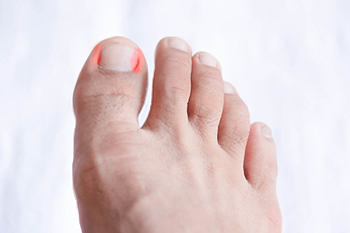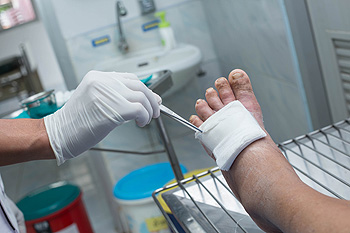Middlefield (860) 349-8500
Wallingford (203) 294-4977
Middlefield (860) 349-8500
Wallingford (203) 294-4977

Flat feet are a common foot ailment that can be easy to observe. While standing up, does the entire foot lie flat on the floor? Most babies are born with flat feet, and the arch generally develops by the teenage years. This may not be the case for some adults, as genetics may contribute to having flat feet. Additionally, if a foot injury has occurred, flat feet may be the result. Many people do not experience pain with flat feet and can complete daily activities. Conversely, flat feet may cause pain and discomfort, and measures can be implemented to help reduce existing pain. These can include performing specific stretches that are tailored for patients with flat feet, in addition to wearing custom-made orthotics. If you have flat feet, it is strongly suggested that you are under the care of a podiatrist who can monitor your balance and general foot health.
Flatfoot is a condition many people suffer from. If you have flat feet, contact Dr. Gordon Fosdick from Affiliated Foot Care Center. Our doctor will treat your foot and ankle needs.
What Are Flat Feet?
Flatfoot is a condition in which the arch of the foot is depressed and the sole of the foot is almost completely in contact with the ground. About 20-30% of the population generally has flat feet because their arches never formed during growth.
Conditions & Problems:
Having flat feet makes it difficult to run or walk because of the stress placed on the ankles.
Alignment – The general alignment of your legs can be disrupted, because the ankles move inward which can cause major discomfort.
Knees – If you have complications with your knees, flat feet can be a contributor to arthritis in that area.
Symptoms
Treatment
If you are experiencing pain and stress on the foot you may weaken the posterior tibial tendon, which runs around the inside of the ankle.
If you have any questions please feel free to contact our offices located in Middlefield and Wallingford, CT . We offer the newest diagnostic and treatment technologies for all your foot and ankle needs.

The entire body changes during pregnancy, and the feet are no exception. Many women notice their feet have grown, which may be attributed to pregnancy hormones the body produces. As the pregnancy progresses, the feet may become swollen, and the arches may flatten as additional weight is gained. Relief may be found when shoes that are worn have a low heel and healthy foods are consumed. It is helpful to refrain from eating salty foods, and frequently elevating the feet may reduce the swelling. Swollen feet may also be a symptom of poor circulation, which may happen from the body recirculating extra fluid that is needed by the growing fetus. It is beneficial to stay as active as possible, drink plenty of water daily, and sleep on the left side. If you have additional questions about how pregnancy can affect the feet, it is suggested that you consult with a podiatrist who can address any concerns you may have.
Pregnant women with swollen feet can be treated with a variety of different methods that are readily available. For more information about other cures for swollen feet during pregnancy, consult with Dr. Gordon Fosdick from Affiliated Foot Care Center. Our doctor will attend to all of your foot and ankle needs.
What Foot Problems Can Arise During Pregnancy?
One problem that can occur is overpronation, which occurs when the arch of the foot flattens and tends to roll inward. This can cause pain and discomfort in your heels while you’re walking or even just standing up, trying to support your baby.
Another problem is edema, or swelling in the extremities. This often affects the feet during pregnancy but tends to occur in the later stages.
How Can I Keep My Feet Healthy During Pregnancy?
If you have any questions please feel free to contact our offices located in Middlefield and Wallingford, CT . We offer the newest diagnostic and treatment technologies for all your foot and ankle needs.

Bone spurs can form on any joint, but the feet are a common location, especially for patients who are 60 years old or above. The reason for this is that bone spurs, medically known as osteophytes, generally take years to grow. They are most often found on the ankle, heel, or big toe. Bone spurs form when bones rub against each other, which is generally the result of wear and tear of a joint, combined with the loss of the cartilage that separates the bones. People with osteoarthritis frequently develop bone spurs. Young athletes may develop bone spurs from injuries that occur during sports. Symptoms of a bone spur include aching pain that worsens with activity, swelling, tingling and numbness, or stiffness. In many cases, however, bone spurs may form without displaying any symptoms at all. An X-ray is thought to be the best way to determine if you have a bone spur. Treatment for bone spurs may include wearing protective padding in the shoes, having cortisone injections, losing weight, and doing certain foot exercises. In some cases, surgery may be a remedy. For more information on how to deal with bone spurs, it is suggested that you visit a podiatrist.
Foot Pain
Foot pain can be extremely painful and debilitating. If you have a foot pain, consult with Dr. Gordon Fosdick from Affiliated Foot Care Center. Our doctor will assess your condition and provide you with quality foot and ankle treatment.
Causes
Foot pain is a very broad condition that could be caused by one or more ailments. The most common include:
Diagnosis
To figure out the cause of foot pain, podiatrists utilize several different methods. This can range from simple visual inspections and sensation tests to X-rays and MRI scans. Prior medical history, family medical history, and any recent physical traumatic events will all be taken into consideration for a proper diagnosis.
Treatment
Treatment depends upon the cause of the foot pain. Whether it is resting, staying off the foot, or having surgery; podiatrists have a number of treatment options available for foot pain.
If you have any questions, please feel free to contact our offices located in Middlefield and Wallingford, CT . We offer the newest diagnostic and treatment technologies for all your foot care needs.

Learning about the biomechanics of the feet can be significantly beneficial for anyone who takes the health of their feet seriously. One aspect of the biomechanics of the feet that everyone ought to know about is the growth of the toenails. The toenails serve important functions, protecting the toes and providing a hard outer armor. There are six parts of the nail, including the root, nail bed, nail plate, eponychium, paronychium and hyponychium. Compared to fingernails, toenails grow at a slower rate. For example, it can take 12 to 18 months for a completely new toenail to grow from the root of the nail to the tip. If an individual has poor circulation, this might further impede toenail growth. If you are someone that is interested in learning more about the toenails, it is recommended that you schedule an appointment with a podiatrist today.
If you have any concerns about your feet, contact Dr. Gordon Fosdick from Affiliated Foot Care Center. Our doctor can provide the care you need to keep you pain-free and on your feet.
Biomechanics in Podiatry
Podiatric biomechanics is a particular sector of specialty podiatry with licensed practitioners who are trained to diagnose and treat conditions affecting the foot, ankle and lower leg. Biomechanics deals with the forces that act against the body, causing an interference with the biological structures. It focuses on the movement of the ankle, the foot and the forces that interact with them.
A History of Biomechanics
Modern technological improvements are based on past theories and therapeutic processes that provide a better understanding of podiatric concepts for biomechanics. Computers can provide accurate information about the forces and patterns of the feet and lower legs.
Understanding biomechanics of the feet can help improve and eliminate pain, stopping further stress to the foot.
If you have any questions please feel free to contact our offices located in Middlefield and Wallingford, CT . We offer the newest diagnostic and treatment technologies for all your foot and ankle needs.

Diabetics are at risk for many types of foot problems, the most common of which is nerve pain. High blood sugar levels can cause damage to the body’s peripheral nerves, and that includes those serving the feet. Another common cause of foot pain in diabetics is peripheral neuropathy, which can result in sharp pain, burning, tingling, and cramps. Circulation problems are caused by high levels of blood sugar that constrict the veins, arteries, and capillaries in the lower extremities. This cuts off blood flow to the feet and slows the healing of any cuts or sores on the ankles and feet. This also leaves the diabetic patient open to an increased likelihood of infections, which may lead to the development of foot ulcers. One of the most destructive causes of foot problems is gangrene, which is the result of both the blood circulation and the neuropathy. If ignored, the affected tissue begins to die and can lead to the loss of a limb if not treated. Signs of diabetic foot problems include changes in skin color, dry or cracked skin on the heels, foot swelling, and inability to detect changes in temperature. It is suggested that people who are diabetic, and especially those with existing foot problems, visit a podiatrist for regular checkups as part of their medical regime and for the safety of their feet.
Diabetic foot care is important in preventing foot ailments such as ulcers. If you are suffering from diabetes or have any other concerns about your feet, contact Dr. Gordon Fosdick from Affiliated Foot Care Center. Our doctor can provide the care you need to keep you pain-free and on your feet.
Diabetic Foot Care
Diabetes affects millions of people every year. The condition can damage blood vessels in many parts of the body, especially the feet. Because of this, taking care of your feet is essential if you have diabetes, and having a podiatrist help monitor your foot health is highly recommended.
The Importance of Caring for Your Feet
Patients with diabetes should have their doctor monitor their blood levels, as blood sugar levels play such a huge role in diabetic care. Monitoring these levels on a regular basis is highly advised.
It is always best to inform your healthcare professional of any concerns you may have regarding your feet, especially for diabetic patients. Early treatment and routine foot examinations are keys to maintaining proper health, especially because severe complications can arise if proper treatment is not applied.
If you have any questions please feel free to contact our offices located in Middlefield and Wallingford, CT . We offer the newest diagnostic and treatment technologies for all your foot and ankle needs.